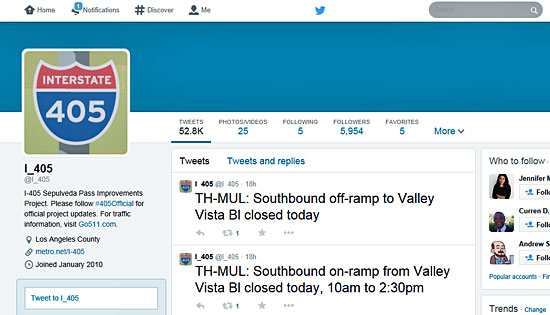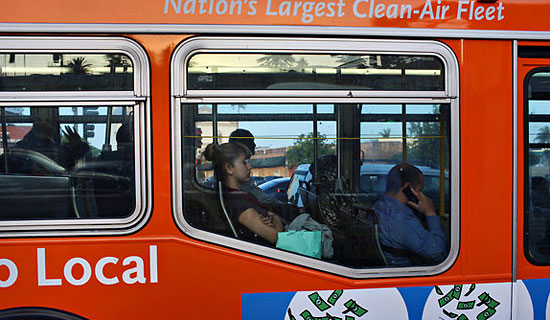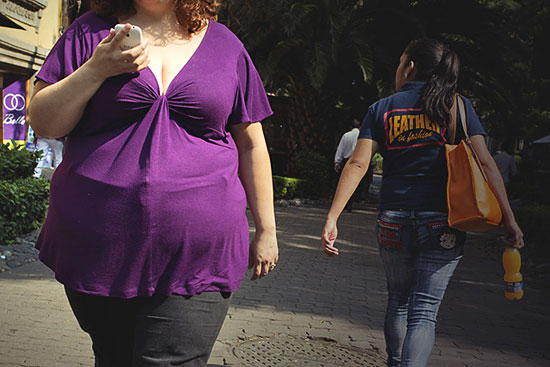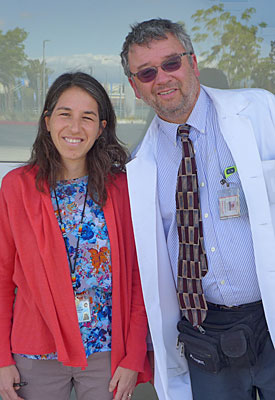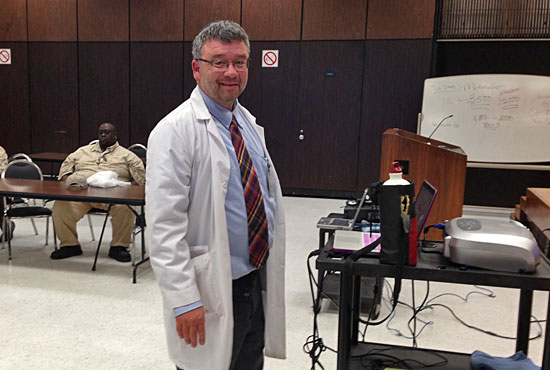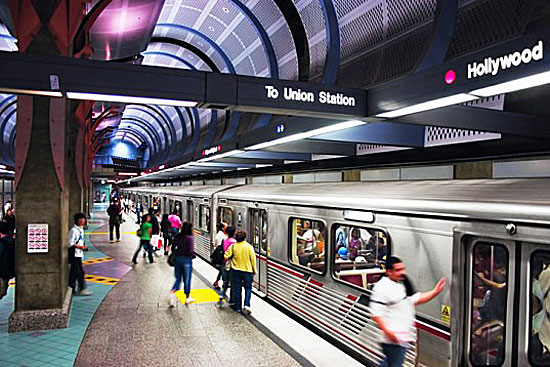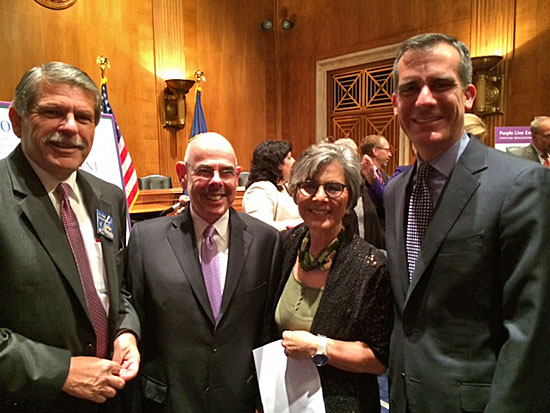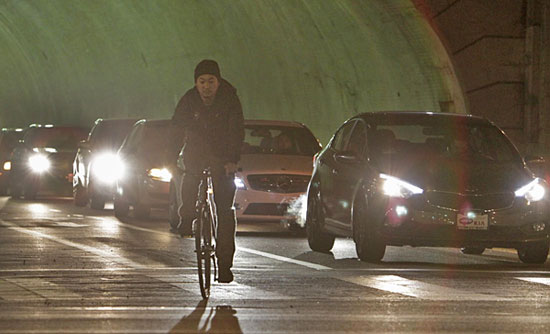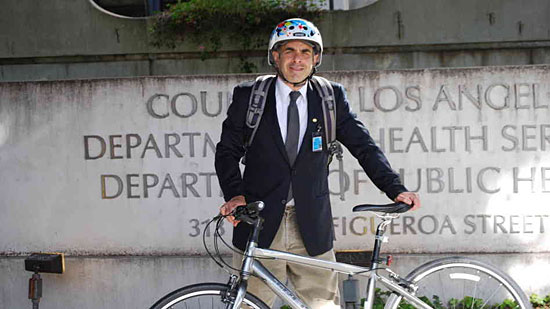It’s not over yet
May 29, 2014
The big milestones are now in the rearview mirror. A much-anticipated carpool lane through the Sepulveda Pass is up and running, massive bridges have been reconstructed from the ground up and soaring new flyover ramps are open for business.
But make no mistake: after nearly five years of construction, the 405 Project is still a work in progress.
A glance at the project’s Twitter feed makes it clear that ramp closures and lane shutdowns are still a daily fact of life in the construction zone. Starting tonight, for the second time this week, the entire southbound freeway will be closed from Getty Center Drive to Wilshire Boulevard so workers can pave and stripe lanes on the roadway’s surface. (Nighttime closures are in effect in that stretch through Monday morning; details are here.)
The ongoing work is needed to accomplish a series of smaller but nevertheless important jobs that remain on the 405 “punch list,” even after last week’s grand opening of the 10-mile northbound carpool lane that’s at the heart of the project.
These tasks include landscaping, drainage and electrical work, completing a wall north of Getty Center Drive, putting up signs, painting lane markings, removing the temporary barriers known as k-rail, and paving sections of the freeway and affected surface streets—particularly a portion of Sepulveda Boulevard, which has had to be literally relocated eastward to accommodate the wider freeway.
“The contractor will be working out there for the remainder of the year,” said Metro spokesman Dave Sotero. “There will be lane and freeway closures intermittently.”
Still, he promises: “No more Jamzillas, Carmageddons, or anything like that. Most of the major work, if not all of the major work, is now open to the public.”
Meanwhile, data are not yet available on travel times and vehicle usage through the Sepulveda Pass since the carpool lane’s opening. Traffic sensors in the pavement won’t be working until electrical work is completed—and that’s another item on the project to-do list.
Posted 5/29/14
The creature from Topanga Creek
May 28, 2014
Louisiana red swamp crayfish may be a delicacy in the gumbo pot, but these voracious Cajun imports are an unwelcome ingredient in Topanga Creek, where they cloud the water and chow down on native fish, bugs and amphibians.
They’ve been in residence since 2001, when a local resident is said to have dumped a batch of live crayfish into the creek in hopes of cultivating a perennial free bait supply. Since then, there have been intermittent community clean-ups, and those efforts—coupled with winter storms that traditionally have washed many of the crustaceans out to sea—were usually enough to keep the population in check. But a lack of significant rainstorms since March 2011 has spawned a crayfish baby boom.
“We’ve had perfect growing conditions for crayfish. The water is slow-moving. It’s warm. And they have gone berserk,” says Rosi Dagit, a senior conservation biologist with the Resource Conservation District of the Santa Monica Mountains. “They’re a very intense predator…It’s kind of gotten out of control.”
That’s bad news for the health of the creek and also for creatures like the California newt, a snack of choice for hungry crayfish.
“One day we literally witnessed a newt in the hands of five crayfish,” says Lizzy Montgomery, 25, a Watershed Stewards Project intern working at the site. Montgomery and her fellow intern, 24-year-old Crystal Garcia, are in the midst of a crayfish research and removal plan now underway at the creek.
They rescued the newt, but the sight of the near-carnage was enough to help Montgomery get over her qualms about dispatching the crayfish with extreme prejudice. (The creek is clean but the crayfish are bottom-feeders and probably not suitable for people to eat, Dagit says. The collected specimens have been frozen and donated to the Nature of Wildworks wildlife center as food for raccoons being rehabilitated there.)
The interns haven’t been working alone. Starting in October, they mobilized a brigade of local schoolchildren from Calvary Christian School in Pacific Palisades and the Topanga Wildlife Youth Project to conduct weekly crayfish removals in a section of the creek. Their haul to date: more than 400 crayfish.
With the end of the school year, the program has gone on hiatus but Montgomery and Garcia say they hope to bring it back. Supervised removals are important because of Topanga Creek’s delicate eco-system; the creek is home to several endangered or threatened species and fishing is prohibited, with special permission required for any crayfish removal, Dagit emphasizes.
Meanwhile, Montgomery and Garcia also are conducting scientific research comparing the cleaned-up area with an adjacent part of the creek where the crayfish continue to run wild. They’ve already created a scientific poster that they’ve presented at two conferences, and hope eventually to have their findings published by the Southern California Academy of Sciences.
Their internships, funded by a grant from the office of Supervisor Zev Yaroslavsky, are set to end in August. After that, it will be time for an all-too-common Southern California pastime—hoping for rain. Even a wet winter probably wouldn’t be enough to completely eliminate the crayfish, which Dagit says are now established in most of the creeks in the Santa Monica Mountains. But it would help keep the invaders in check.
“What we’re hoping is that we’ll get some really good rains and that the population will get severely diminished,” Dagit says. “And at that point we will mobilize people as best we can to do a really concerted removal.”
For a peek at how it’s done, check out the YouTube video below.
Posted 5/28/14
Students fare well on Metro
May 22, 2014
When Metro’s board voted to raise fares today, students got a hall pass.
Metro’s Board of Directors froze student fares at their current rates, while directing staff to explore creating a diversion program to keep fare-evading young people out of the criminal justice system. The action came in response to a motion by Supervisors Mark Ridley-Thomas, Zev Yaroslavsky and Don Knabe, and Mayor Eric Garcetti.
The decision to spare students came after a marathon hearing at which nearly 140 people testified against the fare hikes. Overall, Metro’s base fare will increase by 25 cents to $1.75 this September, while weekly passes will rise from $20 to $25 and monthly passes from $75 to $100. At the same time, the board also voted for the first time to bring free transfers, good for two hours of travel, to the Los Angeles transit system, doing away with the long-running practice of charging $1.50 for each leg of a rider’s journey. The board voted 12-1 to approve the changes, with Supervisor Gloria Molina casting the lone dissenting vote.
The move to focus on students calls attention to one of Metro’s key constituencies.
Metro spends about $10 million a year to subsidize fares for K-12, college and vocational students, agency spokesperson Paul Gonzales said. That translates to big savings for individual riders over time—for example, student monthly passes are just $24 instead of the normal $75. Those discounts are critical for students like Samantha Healy, 15, a sophomore at the Ramon C. Cortines School of Visual and Performing Arts.
“Our families have a lot to pay for already because when you’re a student there’s a lot of stuff you have to do,” Healy said. “It gets expensive.”
Another student interviewed at the Civic Center subway station, India Barrett, said Metro often is the only way she and her friends can get around.
“I think it’s a good idea for fares to stay low because students take the train all the time,” Barrett said. “Parents don’t have the time to take kids everywhere they need to go.”
In April, more than 2 million rides were taken by students during the week, accounting for 10% of Metro’s weekday ridership.
And there’s still room for more to jump aboard. According to a 2009 survey, 51% of L.A. County students aged 5 through 15 usually took private vehicles to school—many doing so even when the trip was a half mile or less. That’s 7% above the national average, said Jessica Meaney, the Southern California policy director for the organization Safe Routes to Schools. Meaney said Thursday’s action represents a step toward getting more families to make use of the transit system.
“Removing barriers for students will increase ridership and help Metro achieve its regional goals,” Meaney said.
For students like 15-year-old Trecey Dory, it all comes down to basic economics.
“Increasing fares? Yeah, that would suck,” Dory said. “It’s hard enough for me to scrape up the $24.”
Tululla Steele, 15, said she hasn’t applied for student fares because she hasn’t gotten an identification card from her school yet. She questioned the logic of raising fares in the first place.
“It is public transportation, after all,” Steele said. “It’s supposed to be affordable.”
Beyond the economic issue, some have complained that citations for fare evasion unnecessarily criminalize young people. The motion approved by Metro’s Board of Directors seeks to change that.
“It pushes to decriminalize a system which gives an adult a ticket and a kid a record,” Mayor Garcetti said.
In approving the motion, the board directed the agency’s staff to report back in September on creating a diversion program, which could include things such as online education and community service in lieu of court appearances and heavy fines. The motion also suggests looking into possible legislative fixes; most adult violations were diverted to Metro’s administrative Transit Court in early 2012, but the L.A. County Superior Court requires juveniles to appear because of state law, said Duane Martin, Metro’s executive officer in charge of transit security.
Out of 110,073 total fare evasion tickets issued in 2013, 10,073 of them went to minors, about half between the hours of 3 p.m. and 6 p.m.
Posted 5/22/14
County fish story no whopper
May 22, 2014

L.A. County crews hauled tons of anchovies and sardines out of the marina, with help from the pelicans.
You could see in the sky that something was fishy.
On Sunday, hundreds of pelicans were dive-bombing the waters of Marina del Rey, while swarms of screaming gulls circled overhead. “It was like a scene out of Hitchcock,” recalled Kenneth Foreman of the Los Angeles County Department of Beaches and Harbors.
But unlike the film version, these frenzied birds (and legions of gluttonous sea lions) were gorging themselves on a spread of anchovies and sardines—a very big, stinky spread. For reasons still unclear, the tiny fish had found their way into a corner of the marina, where they depleted the oxygen and suffocated.
As division chief of the agency’s facilities and property maintenance section, it was Foreman’s job to get rid of the silvery mess that had boaters and residents crying foul.
By late Sunday afternoon, less than a day after the fish surfaced en masse, Foreman’s crews had removed an estimated 6 tons of them. “Our guys did a great job in a short period of time,” said Foreman, a 30-year veteran of the department. For the record, he said, the fish carcasses weren’t placed in a shallow, sandy grave. They were transported by a disposal company to Victorville, where they’ll be converted into compost “so that some beneficial use can come of this.”
The media frenzy that surrounded the weekend die-off and clean-up offered a rare moment in the sun for Foreman’s operation. Away from the glare, his crew tackles everything from cleaning the county’s 51 beach bathrooms to stringing nets on 292 volleyball courts to alerting authorities to the occasional pre-dawn discovery of dead bodies on the sand—some of them apparent suicides.
“I guess the beach was the last thing they wanted to see,” said Foreman, whose 157 employees are also responsible for 1,169 trees, 8.5 miles of sand berms, 4,700 boat slips and 8,161 beach parking stalls.
Every year, between 50 to 60 million visitors flock to the 61 miles of beaches maintained and operated by Los Angeles County. That’s more than all the national parks combined, according to Foreman’s boss at Beaches and Harbors, Deputy Director John Kelly. He said the maintenance division, which has collected 84,000 tons of trash during the past two decades, prides itself on getting the beaches and their restrooms ready before daybreak, unlike some other jurisdictions.
In the early morning, he said, “Santa Monica [beach] parking lots are strewn with trash. You pass by the county beaches, they’re already clean.”
But Foreman’s crews also tackle many less predictable duties that don’t get public notice or end up on the division’s stat sheet.
Foreman said, for example, that in recent years the department increasingly has been called on to help law enforcement authorities deal with “panga” boats abandoned on the sand by drug dealers or illegal immigrants trying to come ashore. The last incident, he said, occurred near Manhattan Beach and led to the arrest of 20 people allegedly trying to enter the country illegally.
More often, however, the department is dispatched to get rid of old, unseaworthy boats that have broken free of makeshift moorings and ended up shipwrecked on the sand.
Sometimes, the division confronts ocean creatures very different from those tiny specimens it encountered over the weekend. It’s not unusual, Foreman said, for dead sea lions, dolphins or whales to wash up on the county’s beaches, as two did in 2012. “Ideally,” he said, “we try to tow them out to sea so Mother Nature can take care of them.” But if it looks like the tide might push them back to shore, “then we try to bury them in the sand.”
“In this department,” he added, “we’ve seen it all. There’s never an opportunity to get bored. Something new and different is going to occur, guaranteed.”
Posted 5/22/14
Texting while thriving
May 22, 2014
We’re a nation of texters, LOL’ing our way to instant (and addictive) connection and communication with those around us.
But those messages don’t have to be mundane, goofy or superficial. In fact, some of them have the potential to save—or at least improve—lives.
Beginning in June, members of Dr. Theodore Friedman’s obesity group at the county’s Martin Luther King, Jr. Multi-Ambulatory Care Center will begin receiving text reminders, tips and other information designed to empower them to stick to health goals. In the new program, the mobile phone acts as a virtual health coach between visits to the doctor.
Maybe it’s a reminder: Zumba class at 4 p.m. Or this techno-friendly nudge: “Did you meet your goal of eating a healthy breakfast today?” Or it could be a “mood” question: “How did you feel when you found out that you had high blood pressure?” If you chose “confused,” another text assures you that your feelings are normal.
“This is a way to harness technology that everybody is using and embracing,” said Dr. Ellen Rothman, interim medical director for the health center. The technology does not allow for live text conversations with the doctor, but between appointments, an automated reminder is next best thing, Rothman said.
This week the County Board of Supervisors approved an agreement between the care center, Charles R. Drew University of Medicine and Science and CareMessage, Inc. to begin a pilot program with about 200 patients who are part of the obesity group, which has been in existence for about 16 months. The initial $500-a-month program is paid for with grant funds from Drew University so there is no direct cost to the county.
“We are going to break down…therapeutic goals into bite-sized pieces,” Rothman said. “A goal might be: I’d like you to walk for 30 minutes a day. I’d like you to cut out that cereal and milk at bedtime that everybody thinks is so healthy; I’d rather have you eat a slice of bread with some peanut butter that’s more filling and nutritional.”
The CareMessage program is not set up to offer advice quite as personalized as Rothman’s. But it can provide a menu of customizable programs designed for specific problems. Options include teen pregnancy, stress management, stress monitoring, smoking cessation or nutrition.
During an initial consultation with a medical professional, the patient will work with the doctor to set up his or her own mobile device to receive text messages. The patient can choose the frequency of reminders or customize a diet or exercise program to their age, weight or fitness level. CareMessage programs are available in English and Spanish.
Friedman chose the obesity group for the pilot because obese patient health care often calls for lifestyle changes rather than medications. That’s where the text-coaching can help, he observed.
“Obesity is not a medical disease,” Friedman said. “This is all about motivation.”
While the text messaging program has not yet begun, current hospital efforts and research point toward potential success. Low-income patients may not have computers or land-line telephones, but 70 to 80% of the care center’s low-income patients have mobile phones with texting capability. “And that’s going to go up each year,” Friedman said.
The facility has seen great improvement in the number of patients showing up for scheduled appointments if they get telephone reminders, but calling is labor-intensive and often results in no answer. Automated texts would not only save time and effort but could also reach a greater number of patients.
If the program expands, the technology may also make it easier for the hospital to gather survey information, too. Paper survey forms can be off-putting but with the new system, “you can do it on your phone while you are waiting for an elevator,” Friedman said.
But key for obesity patients, doctors say, is increasing the odds of lifelong behavioral changes. Among MLK’s economically disadvantaged clients, doctors say they’ve observed an uptick in health literacy over the past 15 years. Still, misinformation abounds, including a widespread belief that clear soda is healthier than colored soda.
“I like the idea of touch points, or teachable moments,” Rothman said. “We have limited resources and a lot of patients. It’s an interesting opportunity to catch people in their teachable moments.”
Posted 5/22/14
It’s official: Feds fund subway
May 21, 2014
As public transit milestones go, they don’t get much bigger than this: The federal government has formally agreed to fund the long-awaited extension of the Purple Line subway into Los Angeles’ traffic-choked Westside.
The $2 billion commitment, announced at a ceremony today in Washington D.C., is truly an historic moment for our region.
As I stood in the Dirksen Senate Office Building this morning, it felt like a pivotal turning point had at last arrived for a project that I have passionately championed and which I firmly believe will bring all of us Angelenos a desperately-needed alternative to sitting in gridlock day after day. It’s been important to me for so many reasons: helping people get to jobs, helping visitors access our amazing cultural institutions, and above all allowing folks to reclaim precious time in their days to spend with their families and in their communities.
Starting now, we have the federal government’s financial backing in bringing relief to one of our most traffic-challenged areas. Today’s “full funding grant agreement” sets in motion a growing subway line that eventually will push past the 405 Freeway.
The federal funding—a $1.25 billion grant and an $856 million low-interest loan—combines with local funding from Measure R to enable us to build the first leg of the subway extension, running from Western Avenue to La Cienega Boulevard. This segment, heading toward completion in 2023, will open up the culturally and jobs-rich Wilshire Corridor to people throughout the county, who will be able to get to renowned attractions like the Los Angeles County Museum of Art and the La Brea Tar Pits without an automobile. It also will blaze the trail for the next two segments, one culminating in Century City and the other at the V.A. in West Los Angeles.
I don’t have to tell anyone reading this blog that traffic congestion in these areas and others has seeped into every facet of daily life in Los Angeles. It affects where we can work, where we play, where we go to lunch and where we attend school, It robs us—and our economy—of untold hours of productive time.
Like you, I’ve fumed behind the wheel as it takes an hour to move two miles, and groaned inwardly that I could jog there in half the time—without breaking a sweat.
That’s not just frustrating—it’s wrong, and something has to change.
Now it will.
The first installment of the agreed-upon federal funding is included in President Obama’s proposed budget for this year. While there are no sure bets in Washington’s current atmosphere, I have every confidence that Congress will move this funding forward annually until the first leg of the project is complete.
As I joined in today’s announcement with U. S. Senators Barbara Boxer and Dianne Feinstein, U.S. Rep. Henry Waxman, Transportation Secretary Anthony Foxx, Metro executives and my fellow elected officials from Los Angeles, I felt gratitude and a surge of pride in the federal-local partnership that has brought us to this point. It is a vote of confidence in Los Angeles County, and in the increasingly vibrant mass transit system we are building here.
And it is a vote of confidence in you, the people of L.A. County. By a two-thirds margin, you went to the polls in 2008 and—despite the Great Recession—approved Measure R’s ½-cent sales tax for transportation projects, including this one.
Today’s action is a vital step in delivering on Measure R’s promise. Together, we’re putting to rest the old myths about our car-crazy metropolis and writing a new chapter about freedom and mobility in the City of Angels.
Posted 5/21/14
Bike boom’s hidden headache
May 15, 2014
There’s good news on the cycling front, with a new report showing L.A. bike use growing by 7.5% and new lanes, paths and “sharrows” buzzing with two-wheeling commuters and recreational cyclists.
But there’s also a less heralded statistic in the 2013 Bike and Ped Count released this week by the Los Angeles County Bicycle Coalition:
Only 46% of L.A. cyclists wear helmets.
That’s troubling to medical experts like Dr. Mitchell Katz, director of the county’s Department of Health Services and a (helmet-wearing) cyclist in his own right.
“The evidence from a medical point of view is very clear: helmets prevent brain injury, and brain injuries are some of the most devastating events besides the possibility that you might actually die,” Katz said.
Katz said his own experiences on the streets of L.A. corroborate the report’s findings on helmet-wearing.
“I’ve noticed that certainly more than half of the bicyclists do not. I think young people are especially guilty of not wearing helmets,” Katz said.
Those riders are taking a big chance, given that 15- to 19-year-olds were the bicyclists likeliest to land in L.A. County emergency rooms in 2012, with 64.3 per 100,000 people in that population showing up to be treated for bike injuries.
Injuries to Los Angeles County cyclists are steadily increasing, from 2,916 hurt in collisions with vehicles in 2007 to 4,759 injured in 2011, according to state data provided by the county Department of Public Health. Twenty-six bike riders were killed in 2007 and 30 in 2011. Only 14% of those injured and just 20% of those killed were using “safety equipment” at the time of their accidents in 2011.
However, the state injury data did not include a specific breakout for helmet usage within the category of “safety equipment”—something Katz said could be helpful in raising consciousness about the dangers of riding without protective headgear.
“I think there is a misconception, that people think, ‘I’m a great bicycle rider. I don’t need to wear a helmet.’ What they’re not thinking of is it doesn’t have anything to do with what kind of bicycle rider I am. It has to do with whether a car hits me and I fly through the air. You don’t have any control, once you’re flying through the air, of how you land,” Katz said.
Adults aren’t legally required to wear bike helmets in California, but advocacy groups like the Bicycle Coalition officially recommend them. And when elected officials like Los Angeles Mayor Eric Garcetti go out for a spin on Bike to Work day, they’re invariably photographed wearing a helmet.
So why aren’t more L.A. cyclists following their lead?
The answer is complicated—and, within the cycling community, often polarizing.
“It can get pretty heated once you start talking about helmet use because there’s a contingent of bicyclists who are really adamant about wearing helmets and there’s a contingent of bicyclists who are really adamant about not wearing a helmet,” said Colin Bogart, education director for the Bicycle Coalition, who advises his students to don helmets and always wears one himself.
Some people “just don’t think it’s that important…it’s the ‘it’s-not-gonna-happen-to-me’ sort of thing,” Bogart said. Then there are those sometimes called “invisible riders”—day laborers and other workers commuting by bike out of necessity and perhaps unable to afford safety equipment like helmets and lights.
And, particularly among younger riders, “there’s the whole coolness factor, right?” Bogart said. “It’s like, ‘You’re a dork if you wear a helmet.’ ”
Underlying the contentious issue is the feeling—held even by bike advocates who strongly recommend helmet use—that too much focus on headgear diverts attention from a broader mission of pushing for better, safer cycling spaces throughout the city.
“I think ultimately what we’d like to see is a situation in which our built environment is such that people don’t even feel like they need to have a helmet because they feel so safe doing it,” Bogart said. “When you look at photographs of people biking in a lot of these cities in the world where the percentage of cycling is way beyond anything we have here, almost nobody is wearing a helmet. [That’s] because it’s viewed as so everyday and so not hazardous to your safety that people just ride without ‘em. “
Although some, like Dr. Katz, think it would be a good idea to pass laws mandating helmet use for adult bicyclists as well as those 18 and under, Bogart said he believes that could deter would-be riders from joining the growing cycling movement.
“That’s a real concern, that if you make it a requirement, a lot of people are just going to say, OK, forget it,” Bogart said.
The helmet statistic was not highlighted in the bike count’s official news release. But it might dovetail with another finding: that fewer than 20% of L.A. cyclists are female. That suggests there still aren’t enough safe bikeways to attract women, traditionally considered more “risk-averse” riders.
To get more women, children and older people bicycling on city streets, the new report calls for creation of more “protected bikeways,” which carve out dedicated space for cyclists to ride with some separation from automobile traffic.
Because let’s face it: “If you’re riding on the streets as they are right now, you’re pretty risk tolerant,” said Eric Bruins, the coalition’s planning and policy director.
Posted 5/15/14
Kindle-ing interest in reading
May 15, 2014
Before Los Angeles County Librarian Margaret Todd boards a plane, she often asks her staff to “surprise” her by uploading some titles to her Kindle. For Todd, relying on the expertise of librarians is like consulting staff recommendations at a bookstore before choosing her next read.
Some library users will soon have a chance for a similar experience when the county’s new eReader Pilot Program begins rolling out. Come June or July, hundreds of Kindle Paperwhite devices—complete with preloaded titles in a variety of genres—will be made available to patrons as easily as taking out any book on the shelves.
“We are trying to learn and grow with our customers,” says Migell Acosta, the library’s assistant director and spokesman. “It’s a way for us to test how our customers want to read their books.”
While numerous public libraries have adopted eBook lending programs for customer-owned devices, Los Angeles County libraries are joining a much shorter list of libraries nationwide that lend eReaders. In 2011, the Sacramento Public Library system became one of California’s earliest adopters of a large-scale eReader program, using the Nook device instead of the Kindle. Acosta says Los Angeles County chose the Kindles because of a tool that allows for easy loading of material and automatic loading of additional titles in the future.
Initially, 705 devices will be made available in 24 libraries throughout the county’s First and Fifth supervisorial districts. Later this summer, three libraries in Supervisor Zev Yaroslavsky’s Third District are expected to join the pilot program, with 190 devices distributed to the Topanga, San Fernando and Agoura Hills libraries.

L.A. County Librarian Margaret Todd says nearly 900 Kindles will be available at selected libraries.
According to librarian Todd, the cost of each is $250, including $80 for content. The devices are primarily being paid for with county funds, with some help from private donations.
Todd says the price is now competitive with the cost of stocking traditional books. “If a kid checks out seven of our books and loses them, they’d have to pay us more than what the Kindle is worth,” she says. The devices have no WiFi and are locked to prevent downloading titles directly from Amazon.
The library plans to treat the devices like traditional books, with two exceptions: They must be returned to the lending library and they cannot be put into book drops because of the potential for damage. Borrowers under 18 must have the same parental permission currently required for borrowing audio and video materials.
Each Kindle comes loaded with 100 public-domain titles selected by Amazon. In addition, each will include 10 to 15 genre titles in more than 30 categories that include biography/memoir, popular nonfiction, urban/street lit, romance and young teen fiction. The reading rosters also include entire book series because library visitors tend to want to borrow them all at once. These include the popular Diary of a Wimpy Kid, Game of Thrones and Lord of the Rings.
As with traditional books, Kindle titles are being selected by the county library’s collection development department, which chooses books for the whole district and are not tailored to any one neighborhood. In that way, collections can easily circulate from library to library, officials say.
To load the devices, library spokesman Acosta says the collections department must consider the Amazon’s eBook price for each title, which can vary like stock prices. “For example, there was a book that won a Pulitzer Prize and the price spiked from $9.99 to $25.99. If a book gets signed for a movie deal, then we see the price spike,” he says.
San Fernando Library manager Hilda Casas is excited about the new program. She says the Kindles will serve as additional available copies of popular books and can be adjusted to larger print for customers who need it.
But in the end, a book is a book, Casas says.
“Some people prefer paperbacks, some people prefer hard copies, some prefer an eReader,” she says. “We’re trying to make that option available.”
Posted 5/15/14
Garden grows more than just plants
May 15, 2014
It’s difficult to predict just how a garden will grow. At Sylmar’s new El Cariso Mountain Garden, they’re harvesting not just tasty veggies but also stronger community bonds.
The garden, which is having its grand opening celebration on Saturday, features 39 raised beds, fruit trees, play areas and even a tricycle path. It’s the latest product of the Little Green Fingers Collaborative, a joint effort by the Los Angeles Conservation Corps and the L.A. Neighborhood Land Trust to serve local families with young children.
And those families have responded enthusiastically.
Wendy Lynch signed up for a plot in part to teach her kids—Travis, 5, and Mbali, 2—where their food comes from.
“Kids love dirt and water, so it’s a ton of fun,” Lynch says. One plot is set aside for “kids to just play and turn the dirt over. It’s filled with kid-proof plants.”
Lynch discovered the garden last fall when it was being built. Her parents spotted the construction in a seldom-used corner of the county’s El Cariso Community Regional Park during their daily walk along the park’s bike path. “They called me up and said ‘You have to get down here,’ ” Lynch recalls.
Lynch, a self-described stay-at-home mom, said she treasures her work in helping to manage the garden, of which she is the current co-treasurer.
“I miss that kind of thing, not working,” Lynch says. “This gives me a real sense of being productive.”
Getting folks like Lynch to grab the reins is essential to the long-term survival of the garden, according to Juan Salas, an organizer with the collaborative. The project is funded through 2017 by First 5 L.A., but then it will be handed over to the community to manage. The gardeners will have to raise the necessary funds to keep things growing.
Another community member, Liziel Estrada, already has helped the garden score a major grant. Estrada discovered and applied for a Grow Your Park grant from the National Recreation and Parks Association. The El Cariso garden was awarded $10,000, making it one of only 15 organizations nationwide to receive a grant. The gardeners plan to use the money to build a gazebo, add new features and continue battling what, so far, has been the biggest threat to a successful harvest—a persistent gopher and rabbit problem.
“The first three months that the gardeners were planting things, they noticed that there were no leaves,” organizer Salas says. “Gophers would pull the plant straight underground just like in the cartoons. I never knew it happened like that but it actually does.”
Additional fencing and wiring installed at the base of the garden beds seems to be helping, and the garden is now growing lush and green. Such challenges are not necessarily a bad thing because they serve as important learning experiences for the young kids who are the primary target of the initiative, says Jessica Monge, who oversees the project for First 5 L.A.
Beyond the open-air fun it offers, the program also aims to combat childhood obesity by promoting healthy eating at home. To that end, hands-on nutrition and cooking classes are part of the program. Estrada says her family has already reaped some of the benefits.
“We’ve had some carrots, we have some kale right now, we’ve had some lettuce,” Estrada says. “Seeing everything grow makes my son want to eat fruits and vegetables even more, which is great.”
But for her fellow gardener Lynch, the most unexpected benefits of the program have been the new connections she’s made.
“When you live in a house you know your immediate neighbors but you don’t meet your community,” Lynch says. “I didn’t know we had a Neighborhood Council; now I know who to go to if I want to get things done. I’ve also made a lot of new friends. With kids, sometimes it’s hard to know who you can trust. You get to see what kind of people they are when they’re working the garden.”
The Sylmar project is the fourth Little Green Fingers garden (others are in Koreatown, South L.A. and Pasadena) and the first to be located in a park.
Most of the garden’s plots already have been reserved by neighborhood families, a school and two local organizations, but those interested in digging in can email Juan Salas ([email protected]) or Monica Curiel ([email protected].) Or they can attend Saturday’s grand opening, from 10 a.m. to 2 p.m. at the western edge of El Cariso Park, 13100 Hubbard Street. There will be educational displays, arts and crafts for kids, and a free lunch prepared by one of the gardeners who is an executive chef at a local restaurant. Picnic blankets are highly recommended.
Posted 5/15/14





